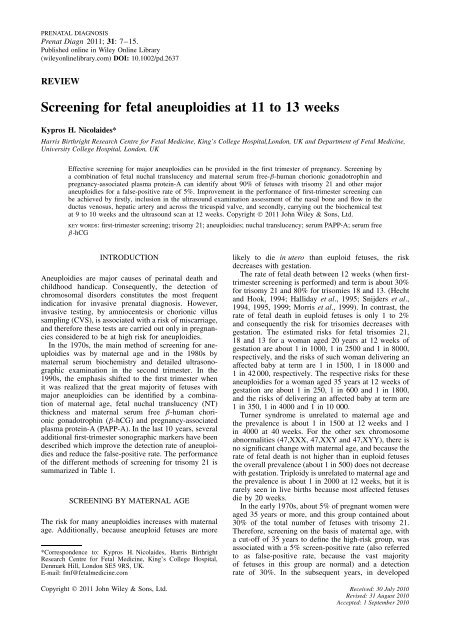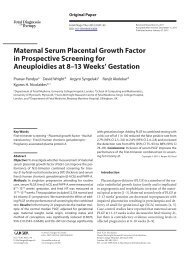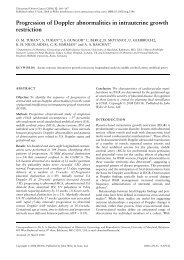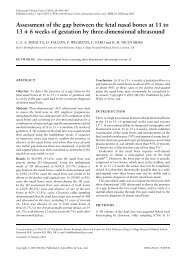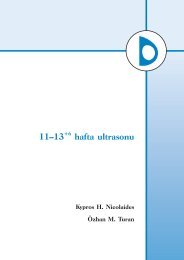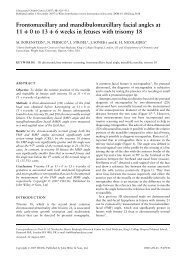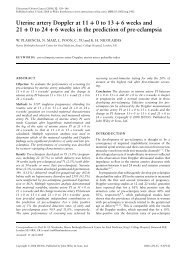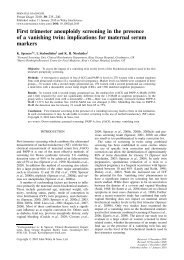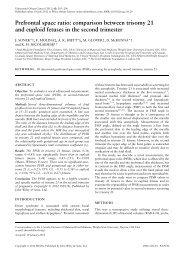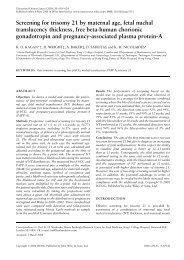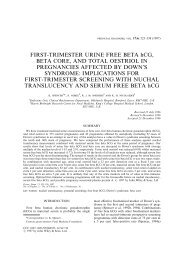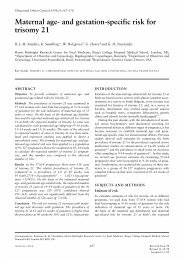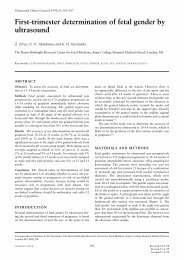Screening for fetal aneuploidies at 11 to 13 weeks - Fetal Medicine
Screening for fetal aneuploidies at 11 to 13 weeks - Fetal Medicine
Screening for fetal aneuploidies at 11 to 13 weeks - Fetal Medicine
Create successful ePaper yourself
Turn your PDF publications into a flip-book with our unique Google optimized e-Paper software.
PRENATAL DIAGNOSIS<br />
Pren<strong>at</strong> Diagn 20<strong>11</strong>; 31: 7–15.<br />
Published online in Wiley Online Library<br />
(wileyonlinelibrary.com) DOI: 10.1002/pd.2637<br />
REVIEW<br />
<strong>Screening</strong> <strong>for</strong> <strong>fetal</strong> <strong>aneuploidies</strong> <strong>at</strong> <strong>11</strong> <strong>to</strong> <strong>13</strong> <strong>weeks</strong><br />
Kypros H. Nicolaides*<br />
Harris Birthright Research Centre <strong>for</strong> <strong>Fetal</strong> <strong>Medicine</strong>, King’s College Hospital,London, UK and Department of <strong>Fetal</strong> <strong>Medicine</strong>,<br />
University College Hospital, London, UK<br />
Effective screening <strong>for</strong> major <strong>aneuploidies</strong> can be provided in the first trimester of pregnancy. <strong>Screening</strong> by<br />
a combin<strong>at</strong>ion of <strong>fetal</strong> nuchal translucency and m<strong>at</strong>ernal serum free-β-human chorionic gonadotrophin and<br />
pregnancy-associ<strong>at</strong>ed plasma protein-A can identify about 90% of fetuses with trisomy 21 and other major<br />
<strong>aneuploidies</strong> <strong>for</strong> a false-positive r<strong>at</strong>e of 5%. Improvement in the per<strong>for</strong>mance of first-trimester screening can<br />
be achieved by firstly, inclusion in the ultrasound examin<strong>at</strong>ion assessment of the nasal bone and flow in the<br />
ductus venosus, hep<strong>at</strong>ic artery and across the tricuspid valve, and secondly, carrying out the biochemical test<br />
<strong>at</strong> 9 <strong>to</strong> 10 <strong>weeks</strong> and the ultrasound scan <strong>at</strong> 12 <strong>weeks</strong>. Copyright © 20<strong>11</strong> John Wiley & Sons, Ltd.<br />
KEY WORDS: first-trimester screening; trisomy 21; <strong>aneuploidies</strong>; nuchal translucency; serum PAPP-A; serum free<br />
β-hCG<br />
INTRODUCTION<br />
Aneuploidies are major causes of perin<strong>at</strong>al de<strong>at</strong>h and<br />
childhood handicap. Consequently, the detection of<br />
chromosomal disorders constitutes the most frequent<br />
indic<strong>at</strong>ion <strong>for</strong> invasive pren<strong>at</strong>al diagnosis. However,<br />
invasive testing, by amniocentesis or chorionic villus<br />
sampling (CVS), is associ<strong>at</strong>ed with a risk of miscarriage,<br />
and there<strong>for</strong>e these tests are carried out only in pregnancies<br />
considered <strong>to</strong> be <strong>at</strong> high risk <strong>for</strong> <strong>aneuploidies</strong>.<br />
In the 1970s, the main method of screening <strong>for</strong> <strong>aneuploidies</strong><br />
was by m<strong>at</strong>ernal age and in the 1980s by<br />
m<strong>at</strong>ernal serum biochemistry and detailed ultrasonographic<br />
examin<strong>at</strong>ion in the second trimester. In the<br />
1990s, the emphasis shifted <strong>to</strong> the first trimester when<br />
it was realized th<strong>at</strong> the gre<strong>at</strong> majority of fetuses with<br />
major <strong>aneuploidies</strong> can be identified by a combin<strong>at</strong>ion<br />
of m<strong>at</strong>ernal age, <strong>fetal</strong> nuchal translucency (NT)<br />
thickness and m<strong>at</strong>ernal serum free β-human chorionic<br />
gonadotrophin (β-hCG) and pregnancy-associ<strong>at</strong>ed<br />
plasma protein-A (PAPP-A). In the last 10 years, several<br />
additional first-trimester sonographic markers have been<br />
described which improve the detection r<strong>at</strong>e of <strong>aneuploidies</strong><br />
and reduce the false-positive r<strong>at</strong>e. The per<strong>for</strong>mance<br />
of the different methods of screening <strong>for</strong> trisomy 21 is<br />
summarized in Table 1.<br />
SCREENING BY MATERNAL AGE<br />
The risk <strong>for</strong> many <strong>aneuploidies</strong> increases with m<strong>at</strong>ernal<br />
age. Additionally, because aneuploid fetuses are more<br />
*Correspondence <strong>to</strong>: Kypros H. Nicolaides, Harris Birthright<br />
Research Centre <strong>for</strong> <strong>Fetal</strong> <strong>Medicine</strong>, King’s College Hospital,<br />
Denmark Hill, London SE5 9RS, UK.<br />
E-mail: fmf@<strong>fetal</strong>medicine.com<br />
likely <strong>to</strong> die in utero than euploid fetuses, the risk<br />
decreases with gest<strong>at</strong>ion.<br />
The r<strong>at</strong>e of <strong>fetal</strong> de<strong>at</strong>h between 12 <strong>weeks</strong> (when firsttrimester<br />
screening is per<strong>for</strong>med) and term is about 30%<br />
<strong>for</strong> trisomy 21 and 80% <strong>for</strong> trisomies 18 and <strong>13</strong>. (Hecht<br />
and Hook, 1994; Halliday et al., 1995; Snijders et al.,<br />
1994, 1995, 1999; Morris et al., 1999). In contrast, the<br />
r<strong>at</strong>e of <strong>fetal</strong> de<strong>at</strong>h in euploid fetuses is only 1 <strong>to</strong> 2%<br />
and consequently the risk <strong>for</strong> trisomies decreases with<br />
gest<strong>at</strong>ion. The estim<strong>at</strong>ed risks <strong>for</strong> <strong>fetal</strong> trisomies 21,<br />
18 and <strong>13</strong> <strong>for</strong> a woman aged 20 years <strong>at</strong> 12 <strong>weeks</strong> of<br />
gest<strong>at</strong>ion are about 1 in 1000, 1 in 2500 and 1 in 8000,<br />
respectively, and the risks of such woman delivering an<br />
affected baby <strong>at</strong> term are 1 in 1500, 1 in 18 000 and<br />
1 in 42 000, respectively. The respective risks <strong>for</strong> these<br />
<strong>aneuploidies</strong> <strong>for</strong> a woman aged 35 years <strong>at</strong> 12 <strong>weeks</strong> of<br />
gest<strong>at</strong>ion are about 1 in 250, 1 in 600 and 1 in 1800,<br />
and the risks of delivering an affected baby <strong>at</strong> term are<br />
1 in 350, 1 in 4000 and 1 in 10 000.<br />
Turner syndrome is unrel<strong>at</strong>ed <strong>to</strong> m<strong>at</strong>ernal age and<br />
the prevalence is about 1 in 1500 <strong>at</strong> 12 <strong>weeks</strong> and 1<br />
in 4000 <strong>at</strong> 40 <strong>weeks</strong>. For the other sex chromosome<br />
abnormalities (47,XXX, 47,XXY and 47,XYY), there is<br />
no significant change with m<strong>at</strong>ernal age, and because the<br />
r<strong>at</strong>e of <strong>fetal</strong> de<strong>at</strong>h is not higher than in euploid fetuses<br />
the overall prevalence (about 1 in 500) does not decrease<br />
with gest<strong>at</strong>ion. Triploidy is unrel<strong>at</strong>ed <strong>to</strong> m<strong>at</strong>ernal age and<br />
the prevalence is about 1 in 2000 <strong>at</strong> 12 <strong>weeks</strong>, but it is<br />
rarely seen in live births because most affected fetuses<br />
dieby20<strong>weeks</strong>.<br />
In the early 1970s, about 5% of pregnant women were<br />
aged 35 years or more, and this group contained about<br />
30% of the <strong>to</strong>tal number of fetuses with trisomy 21.<br />
There<strong>for</strong>e, screening on the basis of m<strong>at</strong>ernal age, with<br />
a cut-off of 35 years <strong>to</strong> define the high-risk group, was<br />
associ<strong>at</strong>ed with a 5% screen-positive r<strong>at</strong>e (also referred<br />
<strong>to</strong> as false-positive r<strong>at</strong>e, because the vast majority<br />
of fetuses in this group are normal) and a detection<br />
r<strong>at</strong>e of 30%. In the subsequent years, in developed<br />
Copyright © 20<strong>11</strong> John Wiley & Sons, Ltd. Received: 30 July 2010<br />
Revised: 31 August 2010<br />
Accepted: 1 September 2010
8 K. H. NICOLAIDES<br />
Table 1—Per<strong>for</strong>mance of different methods of screening <strong>for</strong> trisomy 21<br />
Method of screening Detection r<strong>at</strong>e (%) False-positive r<strong>at</strong>e (%)<br />
MA 30 5<br />
First trimester<br />
MA + <strong>fetal</strong> NT 75–80 5<br />
MA + serum free β-hCG and PAPP-A 60–70 5<br />
MA + NT + free β-hCG and PAPP-A (combined test) 85–95 5<br />
Combined test + nasal bone or tricuspid flow or ductus venosus flow 93–96 2.5<br />
Second trimester<br />
MA + serum AFP, hCG (double test) 55–60 5<br />
MA + serum AFP, free β-hCG (double test) 60–65 5<br />
MA + serum AFP, hCG, uE3 (triple test) 60–65 5<br />
MA + serum AFP, free β-hCG, uE3 (triple test) 65–70 5<br />
MA + serum AFP, hCG, uE3, inhibin A (quadruple test) 65–70 5<br />
MA + serum AFP, free β-hCG, uE3, inhibin A (quadruple test) 70–75 5<br />
MA + NT + PAPP-A (<strong>11</strong>–<strong>13</strong> <strong>weeks</strong>) + quadruple test 90–94 5<br />
MA, m<strong>at</strong>ernal age; NT, nuchal translucency; β-hCG, β-human chorionic gonadotrophin; PAPP-A, pregnancy-associ<strong>at</strong>ed plasma protein-A.<br />
Table 2—Biochemical and sonographic fe<strong>at</strong>ures of trisomies 21, 18 and <strong>13</strong><br />
Euploid Trisomy 21 Trisomy 18 Trisomy <strong>13</strong><br />
NT mixture model<br />
CRL-independent distribution, % 5 95 70 85<br />
Median CRL-independent NT, mm 2.0 3.4 5.5 4.0<br />
Median serum free β-hCG, MoM 1.0 2.0 0.2 0.5<br />
Median serum PAPP-A, MoM 1.0 0.5 0.2 0.3<br />
Absent nasal bone, % 2.5 60 53 45<br />
Tricuspid regurgit<strong>at</strong>ion, % 1.0 55 33 30<br />
Ductus venosus reversed a-wave, % 3.0 66 58 55<br />
NT, nuchal translucency; CRL, crown–rump length; β-hCG, β-human chorionic gonadotrophin; MoM, multiple of the median; PAPP-A,<br />
pregnancy-associ<strong>at</strong>ed plasma protein-A.<br />
countries there was an overall tendency <strong>for</strong> women <strong>to</strong><br />
get pregnant <strong>at</strong> an older age, so th<strong>at</strong> now about 20% of<br />
pregnant women are 35 years or older and this group<br />
contains about 50% of the <strong>to</strong>tal number of fetuses with<br />
trisomy 21.<br />
MATERNAL SERUM BIOCHEMISTRY<br />
Pregnancies with <strong>fetal</strong> <strong>aneuploidies</strong> are associ<strong>at</strong>ed with<br />
altered m<strong>at</strong>ernal serum concentr<strong>at</strong>ions of various fe<strong>to</strong>placental<br />
products, including AFP, free β-hCG, inhibin<br />
A and unconjug<strong>at</strong>ed estriol (uE3) and PAPP-A (Merk<strong>at</strong>z<br />
et al., 1984; Canick et al., 1988; Macri et al., 1990; Van<br />
Lith et al., 1993; Bramb<strong>at</strong>i et al., 1993; Aitken et al.,<br />
1996).<br />
In screening using m<strong>at</strong>ernal serum biochemical<br />
markers, the measured concentr<strong>at</strong>ion of the markers is<br />
converted in<strong>to</strong> a multiple of the median (MOM) of unaffected<br />
pregnancies <strong>at</strong> the same gest<strong>at</strong>ion. The Gaussian<br />
distributions of log10 (MoM) in trisomy 21 and unaffected<br />
pregnancies are then derived, and the r<strong>at</strong>io of the<br />
heights of the distributions <strong>at</strong> a particular MoM, which<br />
is the likelihood r<strong>at</strong>io <strong>for</strong> trisomy 21, is used <strong>to</strong> modify<br />
the apriorim<strong>at</strong>ernal age-rel<strong>at</strong>ed risk <strong>to</strong> derive the<br />
p<strong>at</strong>ient-specific risk.<br />
Second trimester<br />
Early <strong>at</strong>tempts <strong>at</strong> incorpor<strong>at</strong>ing m<strong>at</strong>ernal serum markers<br />
in<strong>to</strong> screening <strong>for</strong> <strong>aneuploidies</strong> focused on the second<br />
trimester of pregnancy and demonstr<strong>at</strong>ed a substantial<br />
improvement in detection r<strong>at</strong>es of trisomy 21, compared<br />
with screening by m<strong>at</strong>ernal age. At a false-positive<br />
r<strong>at</strong>e of 5%, the detection r<strong>at</strong>e improves from 30%<br />
in screening by m<strong>at</strong>ernal age alone <strong>to</strong> 60 <strong>to</strong> 65%<br />
by combining m<strong>at</strong>ernal age with serum AFP and free<br />
β-hCG (double test), 65 <strong>to</strong> 70% with the addition of uE3<br />
(triple test) and 70 <strong>to</strong> 75% with the addition of inhibin A<br />
(quadruple test) (Cuckle et al., 2005; Cuckle and Benn,<br />
2009; Wald et al., 2003a, 2003b). If intact hCG r<strong>at</strong>her<br />
than free β-hCG is used, the detection r<strong>at</strong>es are reduced<br />
by about 5%.<br />
First trimester<br />
In the last decade biochemical testing has moved <strong>to</strong><br />
the first trimester because when this is combined with<br />
the ultrasound marker of <strong>fetal</strong> NT thickness, the per<strong>for</strong>mance<br />
of screening is superior <strong>to</strong> second-trimester<br />
screening. In trisomy 21 pregnancies, the m<strong>at</strong>ernal serum<br />
concentr<strong>at</strong>ion of free β-hCG is about twice as high and<br />
PAPP-A is reduced <strong>to</strong> half compared with euploid pregnancies<br />
(Table 2). The measured serum concentr<strong>at</strong>ions<br />
Copyright © 20<strong>11</strong> John Wiley & Sons, Ltd. Pren<strong>at</strong> Diagn 20<strong>11</strong>; 31: 7–15.<br />
DOI: 10.1002/pd
of these placental products are affected by m<strong>at</strong>ernal<br />
characteristics, including racial origin, weight, smoking<br />
and method of conception as well as the machine and<br />
reagents used <strong>for</strong> the analysis. Consequently, in the calcul<strong>at</strong>ion<br />
of risk <strong>for</strong> <strong>aneuploidies</strong> using these products it<br />
is necessary <strong>to</strong> take in<strong>to</strong> account the effects of these<br />
m<strong>at</strong>ernal variables in defining MoMs be<strong>for</strong>e comparing<br />
affected and unaffected pregnancies (Kagan et al.,<br />
2008a). In euploid pregnancies, the average adjusted<br />
value <strong>for</strong> both free β-hCG and PAPP-A is 1.0 MoM<br />
<strong>at</strong> all gest<strong>at</strong>ions, whereas in trisomy 21 the average free<br />
β-hCG is 2.0 MoM and the average PAPP-A is 0.5 MoM<br />
and they both increase with gest<strong>at</strong>ion.<br />
In screening <strong>for</strong> trisomy 21 by m<strong>at</strong>ernal age and serum<br />
free β-hCG and PAPP-A, the detection r<strong>at</strong>e is about 65%<br />
<strong>for</strong> a false-positive r<strong>at</strong>e of 5%. The per<strong>for</strong>mance is better<br />
<strong>at</strong> 9 <strong>to</strong> 10 <strong>weeks</strong> than <strong>at</strong> <strong>13</strong> <strong>weeks</strong> because the difference<br />
in PAPP-A between trisomic and euploid pregnancies<br />
is gre<strong>at</strong>er in earlier gest<strong>at</strong>ions (Cuckle and van Lith,<br />
1999; Spencer et al., 2003a; Kagan et al., 2008a; Wright<br />
et al., 2010). Although the difference in free β-hCG<br />
between trisomic and euploid pregnancies increases with<br />
gest<strong>at</strong>ion, the magnitude of the difference is smaller than<br />
th<strong>at</strong> of the opposite rel<strong>at</strong>ion of PAPP-A.<br />
In trisomies 18 and <strong>13</strong>, m<strong>at</strong>ernal serum free β-hCG<br />
and PAPP-A are decreased (Tul et al., 1999; Spencer<br />
et al., 2000a). In cases of sex chromosomal anomalies,<br />
m<strong>at</strong>ernal serum free β-hCG is normal and PAPP-A<br />
is low (Spencer et al., 2000b). In diandric triploidy,<br />
m<strong>at</strong>ernal serum free β-hCG is gre<strong>at</strong>ly increased, whereas<br />
PAPP-A is mildly decreased (Spencer et al., 2000c).<br />
Digynic triploidy is associ<strong>at</strong>ed with markedly decreased<br />
m<strong>at</strong>ernal serum free β-hCG and PAPP-A.<br />
A new biochemical marker of <strong>aneuploidies</strong> is<br />
ADAM12 (A disintegrin and metalloprotease) because<br />
in trisomic pregnancies m<strong>at</strong>ernal serum levels during<br />
the first trimester are lower than in euploid pregnancies<br />
(Christiansen et al., 2010). However, it is unlikely<br />
th<strong>at</strong> this marker will improve screening, because the<br />
reduction is small and there is a significant associ<strong>at</strong>ion<br />
between ADAM12 and the traditional biochemical<br />
markers of free β-hCG and PAPP-A (Poon et al., 2009).<br />
SCREENING BY FETAL NT THICKNESS<br />
In 1866, Langdon Down reported th<strong>at</strong> in individuals<br />
with trisomy 21 (the condition th<strong>at</strong> came <strong>to</strong> bear his<br />
name), the skin appears <strong>to</strong> be <strong>to</strong>o large <strong>for</strong> their body<br />
(Langdon Down, 1866). In the 1990s, it was realized th<strong>at</strong><br />
this excess skin may be the consequence of excessive<br />
accumul<strong>at</strong>ion of subcutaneous fluid behind the <strong>fetal</strong><br />
neck which could be visualized by ultrasonography as<br />
increased NT in the third month of intrauterine life<br />
(Nicolaides et al., 1992a).<br />
Extensive research in the last 20 years has established<br />
th<strong>at</strong> the measurement of <strong>fetal</strong> NT thickness provides<br />
effective and early screening <strong>for</strong> trisomy 21 and other<br />
major <strong>aneuploidies</strong> (Snijders et al., 1998; Wald et al.,<br />
2003a; Nicolaides, 2004; Malone et al., 2005). Furthermore,<br />
high NT is associ<strong>at</strong>ed with cardiac defects and a<br />
SCREENING FOR FETAL ANEUPLOIDIES AT <strong>11</strong> <strong>to</strong> <strong>13</strong> WEEKS 9<br />
wide range of other <strong>fetal</strong> mal<strong>for</strong>m<strong>at</strong>ions and genetic syndromes<br />
(Hyett et al., 1996a; Souka et al., 1998, 2005).<br />
The optimal gest<strong>at</strong>ional age <strong>for</strong> measurement of <strong>fetal</strong><br />
NT is <strong>11</strong> <strong>to</strong> <strong>13</strong> <strong>weeks</strong> and 6 days. The minimum<br />
<strong>fetal</strong> crown–rump length (CRL) should be 45 mm and<br />
the maximum 84 mm. The lower limit is selected <strong>to</strong><br />
allow the sonographic diagnosis of many major <strong>fetal</strong><br />
abnormalities, which would have otherwise been missed,<br />
and the upper limit is such <strong>to</strong> provide women with<br />
affected fetuses the option of an earlier and safer<br />
<strong>for</strong>m of termin<strong>at</strong>ion. <strong>Fetal</strong> NT can be measured either<br />
by transabdominal or transvaginal sonography and the<br />
results are similar.<br />
The ability <strong>to</strong> achieve a reliable measurement of NT<br />
is dependent on appropri<strong>at</strong>e training of sonographers,<br />
adherence <strong>to</strong> a standard ultrasound technique in order <strong>to</strong><br />
achieve uni<strong>for</strong>mity of results among different oper<strong>at</strong>ors.<br />
The magnific<strong>at</strong>ion of the image should be high so th<strong>at</strong><br />
only the <strong>fetal</strong> head and upper thorax are included in<br />
the picture. A good sagittal section of the fetus in the<br />
neutral position should be obtained, and the maximum<br />
thickness of the subcutaneous translucency between the<br />
skin and the soft tissue overlying the cervical spine<br />
should be measured. The mid-sagittal view of the <strong>fetal</strong><br />
face is defined by the presence of the echogenic tip of<br />
the nose and rectangular shape of the pal<strong>at</strong>e anteriorly,<br />
the translucent diencephalon in the center and the<br />
nuchal membrane posteriorly (Plasencia et al., 2007).<br />
Devi<strong>at</strong>ions from the exact midline plane result in nonvisualiz<strong>at</strong>ion<br />
of the tip of the nose and visibility of the<br />
zygom<strong>at</strong>ic process of the maxilla.<br />
There are three elements in the assessment of NT<br />
th<strong>at</strong> can introduce oper<strong>at</strong>or bias and either underor<br />
overestim<strong>at</strong>ion of the measurement and consequent<br />
increase in the variability of measurements. Firstly,<br />
the selection of the exact place behind the <strong>fetal</strong> neck<br />
containing the maximum vertical distance between the<br />
nuchal membrane and the edge of the soft tissue<br />
overlying the cervical spine because the two lines<br />
are not usually parallel, secondly, the selection of the<br />
appropri<strong>at</strong>e gain <strong>to</strong> reduce the thickness of the lines and<br />
thirdly, accur<strong>at</strong>e placement of the calipers on the two<br />
lines. In order <strong>to</strong> avoid these problems, a semi-au<strong>to</strong>m<strong>at</strong>ed<br />
method of measuring NT thickness has been developed<br />
which has the potential <strong>to</strong> substantially reduce betweenand<br />
within-oper<strong>at</strong>or variability in measurements of NT<br />
from a given image (Mor<strong>at</strong>alla et al., 2010).<br />
<strong>Fetal</strong> NT increases with CRL and there<strong>for</strong>e it is essential<br />
<strong>to</strong> take gest<strong>at</strong>ion in<strong>to</strong> account when determining<br />
whether a given NT thickness is increased. There are<br />
essentially two approaches <strong>to</strong> quantifying the devi<strong>at</strong>ion<br />
of NT from the normal median. One approach is <strong>to</strong> subtract<br />
the normal median from the NT measurement and<br />
<strong>to</strong> produce a devi<strong>at</strong>ion in millimeters referred <strong>to</strong> as delta<br />
NT (Pandya et al., 1995a; Spencer et al., 2003b). The<br />
other approach is <strong>to</strong> divide NT by the normal median <strong>to</strong><br />
produce a MoM value (Nicolaides et al., 1998). In the<br />
calcul<strong>at</strong>ion of p<strong>at</strong>ient-specific risks <strong>for</strong> trisomy 21, the a<br />
priori m<strong>at</strong>ernal age-rel<strong>at</strong>ed risk is multiplied by the likelihood<br />
r<strong>at</strong>io <strong>for</strong> a measured NT, which is the r<strong>at</strong>io of the<br />
heights of distributions of measurements in trisomy 21<br />
and unaffected pregnancies. Recently, a new approach<br />
Copyright © 20<strong>11</strong> John Wiley & Sons, Ltd. Pren<strong>at</strong> Diagn 20<strong>11</strong>; 31: 7–15.<br />
DOI: 10.1002/pd
10 K. H. NICOLAIDES<br />
has been proposed <strong>for</strong> quantifying the devi<strong>at</strong>ion in the<br />
measured NT from the normal. This is based on the<br />
observ<strong>at</strong>ion th<strong>at</strong> in both aneuploid and euploid pregnancies,<br />
<strong>fetal</strong> NT follows two distributions, one which is<br />
CRL dependent and another which is CRL independent<br />
(Wright et al., 2008). In this mixture model, the distribution<br />
in which NT increases with CRL is observed<br />
in about 95% of euploid fetuses, 5% with trisomy 21,<br />
30% with trisomy 18, 15% with trisomy <strong>13</strong> and 10%<br />
with Turner syndrome. The median CRL-independent<br />
NT was 2.0 mm <strong>for</strong> the euploid group and 3.4, 5.5, 4.0<br />
and 7.8 mm <strong>for</strong> trisomies 21, 18, <strong>13</strong> and Turner syndrome,<br />
respectively.<br />
Several prospective interventional studies in hundreds<br />
of thousands of pregnancies have demonstr<strong>at</strong>ed th<strong>at</strong><br />
firstly, <strong>fetal</strong> NT is successfully measured in more<br />
than 99% of cases, secondly, the risk of chromosomal<br />
abnormalities increases with both m<strong>at</strong>ernal age and <strong>fetal</strong><br />
NT thickness and thirdly, in pregnancies with low <strong>fetal</strong><br />
NT the m<strong>at</strong>ernal age-rel<strong>at</strong>ed risk is decreased. For a<br />
5% false-positive r<strong>at</strong>e, <strong>fetal</strong> NT screening identifies 75<br />
<strong>to</strong> 80% of fetuses with trisomy 21 and other major<br />
<strong>aneuploidies</strong> (Nicolaides, 2004).<br />
SCREENING BY FETAL NT THICKNESS<br />
AND SERUM BIOCHEMISTRY<br />
There is no significant associ<strong>at</strong>ion between <strong>fetal</strong> NT<br />
and m<strong>at</strong>ernal serum free β-hCG or PAPP-A in either<br />
trisomy 21 or euploid pregnancies, and there<strong>for</strong>e the<br />
ultrasononographic and biochemical markers can be<br />
combined <strong>to</strong> provide more effective screening than either<br />
method individually (Brizot et al., 1994, 1995; Noble<br />
et al., 1995; Spencer et al., 1999).<br />
Several prospective interventional studies in many<br />
thousands of pregnancies have demonstr<strong>at</strong>ed th<strong>at</strong> <strong>for</strong> a<br />
5% false-positive r<strong>at</strong>e, the first-trimester combined test<br />
identifies about 90% of trisomy 21 pregnancies (Krantz<br />
et al., 2000; Bindra et al., 2002; Schuchter et al., 2002;<br />
Spencer et al., 2003c; Wapner et al., 2003; Nicolaides<br />
et al., 2005; Ekelund et al., 2008; Kagan et al., 2009a;<br />
Leung et al., 2009).<br />
Timing of ultrasound and blood testing<br />
within the first trimester<br />
One option in first-trimester combined screening <strong>for</strong> trisomy<br />
21 is <strong>to</strong> per<strong>for</strong>m biochemical and ultrasonographic<br />
testing as well as <strong>to</strong> counsel women in one-s<strong>to</strong>p clinics<br />
<strong>for</strong> assessment of risk (OSCAR) (Bindra et al., 2002;<br />
Spencer et al., 2000d). This has been made possible by<br />
the introduction of biochemical analyzers which provide<br />
au<strong>to</strong>m<strong>at</strong>ed, precise and reproducible measurements<br />
within 30 min of obtaining a blood sample. The ideal<br />
gest<strong>at</strong>ion <strong>for</strong> OSCAR is 12 <strong>weeks</strong> because the aim of<br />
the first-trimester scan is not just <strong>to</strong> screen <strong>for</strong> trisomy<br />
21 but also <strong>to</strong> diagnose an increasing number of <strong>fetal</strong><br />
mal<strong>for</strong>m<strong>at</strong>ions, and in this respect the ability <strong>to</strong> visualize<br />
<strong>fetal</strong> an<strong>at</strong>omy is best <strong>at</strong> 12 <strong>weeks</strong> (Souka et al.,<br />
2004). The detection r<strong>at</strong>e of trisomy 21 with OSCAR <strong>at</strong><br />
12 <strong>weeks</strong> is about 90% <strong>at</strong> a false-positive r<strong>at</strong>e of 5%.<br />
An altern<strong>at</strong>ive str<strong>at</strong>egy <strong>for</strong> first-trimester combined<br />
screening is <strong>for</strong> biochemical testing and ultrasound<br />
scanning <strong>to</strong> be carried out in two separ<strong>at</strong>e visits, with the<br />
first done <strong>at</strong> 9 <strong>to</strong> 10 <strong>weeks</strong> and the second <strong>at</strong> 12 <strong>weeks</strong><br />
(Borrell et al., 2004; Kagan, 2008b; Kirkegaard et al.,<br />
2008; Wright et al., 2010). It has been estim<strong>at</strong>ed th<strong>at</strong><br />
this approach would improve the detection r<strong>at</strong>e from<br />
90% <strong>to</strong> 93 <strong>to</strong> 94%. A third option would be <strong>to</strong> per<strong>for</strong>m<br />
the scan <strong>at</strong> 12 <strong>weeks</strong> and optimize the per<strong>for</strong>mance of<br />
biochemical testing by measuring PAPP-A <strong>at</strong> 9 <strong>weeks</strong><br />
and free β-hCG <strong>at</strong> the time of the scan <strong>at</strong> 12 <strong>weeks</strong> or<br />
even l<strong>at</strong>er with an estim<strong>at</strong>ed detection r<strong>at</strong>e of 95%. The<br />
cost and p<strong>at</strong>ient acceptability of the altern<strong>at</strong>ive policies<br />
of first trimester testing will depend on the existing<br />
infrastructure of anten<strong>at</strong>al care. The potential advantage<br />
of two- or three-stage screening in terms of detection r<strong>at</strong>e<br />
may be eroded by the likely increased non-compliance<br />
with the additional steps.<br />
Additional first-trimester sonographic<br />
markers<br />
In addition <strong>to</strong> NT, other highly sensitive and specific<br />
first-trimester sonographic markers of trisomy 21 are<br />
absence of the nasal bone, increased impedance <strong>to</strong><br />
flow in the ductus venosus and tricuspid regurgit<strong>at</strong>ion<br />
(Table 2). Absence of the nasal bone, reversed a-wave<br />
in the ductus venosus and tricuspid regurgit<strong>at</strong>ion are<br />
observed in about 60, 66 and 55% of fetuses with<br />
trisomy 21 and in 2.5, 3.0 and 1.0%, respectively, of<br />
euploid fetuses. (M<strong>at</strong>ias et al., 1998; Cicero et al., 2001,<br />
2006; Huggon et al., 2003; Nicolaides, 2004; Faiola<br />
et al., 2005; Falcon et al., 2006; Kagan et al., 2009b,<br />
2009c; Maiz et al., 2009).<br />
Assessment of each of these ultrasound markers can<br />
be incorpor<strong>at</strong>ed in<strong>to</strong> first-trimester combined screening<br />
by m<strong>at</strong>ernal age, <strong>fetal</strong> NT and serum free β-hCG and<br />
PAPP-A resulting in improvement of the per<strong>for</strong>mance<br />
of screening with an increase in detection r<strong>at</strong>e <strong>to</strong> 93<br />
<strong>to</strong> 96% and a decrease in false-positive r<strong>at</strong>e <strong>to</strong> 2.5%<br />
(Kagan et al., 2009b, 2009c; Maiz et al., 2009). A<br />
similar per<strong>for</strong>mance of screening can be achieved by<br />
a contingent policy in which first-stage screening by<br />
m<strong>at</strong>ernal age, <strong>fetal</strong> NT and serum free β-hCG and PAPP-<br />
A is offered <strong>to</strong> all cases. P<strong>at</strong>ients with a risk of 1 in 50<br />
or more are considered <strong>to</strong> be screen positive and those<br />
with a risk of less than 1 in 1000 are screen neg<strong>at</strong>ive.<br />
P<strong>at</strong>ients with the intermedi<strong>at</strong>e risk of 1 in 51 <strong>to</strong> 1 in 1000,<br />
which constitutes about 15% of the <strong>to</strong>tal popul<strong>at</strong>ion,<br />
have second-stage screening with nasal bone, ductus<br />
venosus or tricuspid blood flow which modifies their<br />
first-stage risk. If the adjusted risk is 1 in 100 or more,<br />
the p<strong>at</strong>ients are considered <strong>to</strong> be screen positive and<br />
those with a risk of less than 1 in 100 are screen neg<strong>at</strong>ive.<br />
A recently described first-trimester sonographic marker<br />
of trisomy 21 is increased flow in the <strong>fetal</strong> hep<strong>at</strong>ic<br />
artery (Bilardo et al., 2010; Zvanca et al., 20<strong>11</strong>). This<br />
marker is also likely <strong>to</strong> find an applic<strong>at</strong>ion in the<br />
Copyright © 20<strong>11</strong> John Wiley & Sons, Ltd. Pren<strong>at</strong> Diagn 20<strong>11</strong>; 31: 7–15.<br />
DOI: 10.1002/pd
assessment of the intermedi<strong>at</strong>e risk group after first-stage<br />
combined screening.<br />
Individual risk-orient<strong>at</strong>ed two-stage screening <strong>for</strong> trisomy<br />
21 is comp<strong>at</strong>ible with the basic principles of clinical<br />
practice in all fields of medicine. For example, in<br />
the gre<strong>at</strong> majority of p<strong>at</strong>ients presenting with abdominal<br />
pain, the correct diagnosis of the presence or absence<br />
of a serious problem is reached after his<strong>to</strong>ry taking and<br />
clinical examin<strong>at</strong>ion. In a minority of cases, a series of<br />
further investig<strong>at</strong>ions of increasing sophistic<strong>at</strong>ion may<br />
be necessary be<strong>for</strong>e the correct diagnosis is made.<br />
Selective use of ultrasound or biochemistry<br />
within the first trimester<br />
The best per<strong>for</strong>mance of first-trimester screening is<br />
achieved by a combin<strong>at</strong>ion of m<strong>at</strong>ernal age, serum<br />
biochemical testing and multiple sonographic markers.<br />
At a risk cut-off of 1 in 100, the detection r<strong>at</strong>e of trisomy<br />
21 is about 95% <strong>at</strong> a false-positive r<strong>at</strong>e of 2.5%. This<br />
per<strong>for</strong>mance of screening is achieved by either a policy<br />
in which biochemical testing is undertaken in all cases<br />
or by a contingent policy in which first-stage screening<br />
is based on m<strong>at</strong>ernal age, <strong>fetal</strong> NT and either tricuspid<br />
or ductus venosus flow, and biochemical testing is then<br />
per<strong>for</strong>med in only those with an intermedi<strong>at</strong>e risk, which<br />
constitute about 20% of the <strong>to</strong>tal (Kagan et al., 2010a).<br />
An altern<strong>at</strong>ive first-trimester contingent screening policy<br />
consists of m<strong>at</strong>ernal serum biochemistry in all pregnancies<br />
followed by <strong>fetal</strong> NT only in those with an<br />
intermedi<strong>at</strong>e risk after biochemical testing. Studies<br />
examining the potential per<strong>for</strong>mance of such policy have<br />
estim<strong>at</strong>ed th<strong>at</strong> the detection r<strong>at</strong>es and false-positive r<strong>at</strong>es<br />
wouldbe80<strong>to</strong>90%and4<strong>to</strong>6%,respectively,and<br />
measurement of <strong>fetal</strong> NT would be necessary in only<br />
20 <strong>to</strong> 40% of cases (Christiansen et al., 2002; Wright<br />
et al., 2004; Vadiveloo et al., 2009; Kagan et al., 2010a;<br />
Sahota et al., 2010). The advantage of biochemical testing<br />
as a first-stage policy relies on its apparent simplicity.<br />
However, interpret<strong>at</strong>ion of biochemical results<br />
necessit<strong>at</strong>es accur<strong>at</strong>e ultrasonographic measurement of<br />
<strong>fetal</strong> CRL and there<strong>for</strong>e an ultrasound examin<strong>at</strong>ion cannot<br />
be avoided. In the studies estim<strong>at</strong>ing the potential<br />
per<strong>for</strong>mance of contingent screening, the <strong>fetal</strong> CRL was<br />
measured by appropri<strong>at</strong>ely trained sonographers during<br />
assessment of <strong>fetal</strong> NT. It would be wrong <strong>to</strong> assume<br />
th<strong>at</strong> the motiv<strong>at</strong>ion of sonographers and the accuracy<br />
in measuring CRL would remain as high if the scans<br />
were carried out purely <strong>for</strong> measurement of CRL and<br />
not examining the fetus.<br />
Major advantages of choosing ultrasound assessment<br />
r<strong>at</strong>her than biochemical testing as a first-stage policy are<br />
th<strong>at</strong> firstly, there is a substantial reduction in the cost<br />
of screening because measurement of m<strong>at</strong>ernal serum<br />
free β-hCG and PAPP-A is undertaken in only 20%<br />
r<strong>at</strong>her than all pregnancies, secondly, the <strong>fetal</strong> an<strong>at</strong>omy<br />
can be examined leading <strong>to</strong> early diagnosis of many<br />
major abnormalities in all pregnancies r<strong>at</strong>her than in just<br />
the subgroup with positive first-stage screening results,<br />
thirdly, the Doppler studies can be carried out in the<br />
same ultrasound examin<strong>at</strong>ion as <strong>for</strong> measurement of<br />
SCREENING FOR FETAL ANEUPLOIDIES AT <strong>11</strong> <strong>to</strong> <strong>13</strong> WEEKS <strong>11</strong><br />
<strong>fetal</strong> NT and fourthly, reversed a-wave in the ductus<br />
venosus or tricuspid regurgit<strong>at</strong>ion are not only useful in<br />
screening <strong>for</strong> trisomy 21 and other major <strong>aneuploidies</strong>,<br />
but also they can identify pregnancies <strong>at</strong> increased risk<br />
<strong>for</strong> cardiac defects and adverse pregnancy outcome. The<br />
disadvantage is th<strong>at</strong> Doppler assessment of tricuspid and<br />
ductus venosus flow can be time consuming and requires<br />
appropri<strong>at</strong>ely trained sonographers.<br />
First-trimester screening followed<br />
by second-trimester scan<br />
In the second trimester scan, each chromosomal defect<br />
has its own syndromal p<strong>at</strong>tern of detectable abnormalities<br />
(Nicolaides et al., 1992b; Nicolaides, 1996). For<br />
example, trisomy 21 is associ<strong>at</strong>ed with cardiac defects,<br />
duodenal <strong>at</strong>resia, nasal hypoplasia, increased nuchal fold<br />
and prenasal thickness, intracardiac echogenic foci, and<br />
echogenic bowel, mild hydronephrosis, shortening of the<br />
femur and more so of the humerus, sandal gap and<br />
mid-phalanx hypoplasia of the fifth finger. In trisomy<br />
18, common findings include strawberry-shaped head,<br />
choroid plexus cysts, absent corpus callosum, enlarged<br />
cisterna magna, facial cleft, microgn<strong>at</strong>hia, nuchal edema,<br />
heart defects, diaphragm<strong>at</strong>ic hernia, esophageal <strong>at</strong>resia,<br />
exomphalos, single umbilical artery, renal abnormalities,<br />
echogenic bowel, myelomeningocoele, growth<br />
restriction and shortening of the limbs, radial aplasia,<br />
overlapping fingers and talipes or rocker bot<strong>to</strong>m<br />
feet. Trisomy <strong>13</strong> is associ<strong>at</strong>ed with holoprosencephaly,<br />
microcephaly, facial abnormalities, cardiac abnormalities,<br />
enlarged and echogenic kidneys, exomphalos and<br />
post axial polydactyly.<br />
If the second-trimester scan demonstr<strong>at</strong>es major<br />
abnormalities, it is advisable <strong>to</strong> offer <strong>fetal</strong> karyotyping,<br />
even if these abnormalities are apparently isol<strong>at</strong>ed. The<br />
prevalence of such abnormalities is low and there<strong>for</strong>e<br />
the cost implic<strong>at</strong>ions are small. If the abnormalities are<br />
either lethal or they are associ<strong>at</strong>ed with severe handicap,<br />
such as holoprosencephaly, <strong>fetal</strong> karyotyping constitutes<br />
one of a series of investig<strong>at</strong>ions <strong>to</strong> determine<br />
the possible cause and thus the risk of recurrence. If<br />
the abnormality is potentially correctable by intrauterine<br />
or postn<strong>at</strong>al surgery, such as diaphragm<strong>at</strong>ic hernia, it<br />
may be logical <strong>to</strong> exclude an underlying chromosomal<br />
defect—especially because, <strong>for</strong> many of these conditions,<br />
the usual defect is trisomy 18 or <strong>13</strong>.<br />
Minor <strong>fetal</strong> abnormalities or soft markers are common<br />
and they are not usually associ<strong>at</strong>ed with any handicap,<br />
unless there is an underlying chromosomal defect.<br />
Routine karyotyping of all pregnancies with these markers<br />
would have major implic<strong>at</strong>ions, both in terms of<br />
miscarriage and in economic costs. It is best <strong>to</strong> base<br />
counseling on an individual estim<strong>at</strong>ed risk <strong>for</strong> a chromosomal<br />
defect, r<strong>at</strong>her than the arbitrary advice th<strong>at</strong><br />
invasive testing is recommended because the risk is<br />
‘high’. The individual risk can be derived by multiplying<br />
the apriori risk (based on the results of previous<br />
screening by NT and/or biochemistry in the current pregnancy)<br />
by the likelihood r<strong>at</strong>io of the specific abnormality<br />
or marker (Benacerraf et al., 1992; Vintzileos and Egan,<br />
Copyright © 20<strong>11</strong> John Wiley & Sons, Ltd. Pren<strong>at</strong> Diagn 20<strong>11</strong>; 31: 7–15.<br />
DOI: 10.1002/pd
12 K. H. NICOLAIDES<br />
1995, Vintzileos et al., 1996; Bahado-Singh et al., 1998;<br />
Nyberg et al., 2001; Smith-Bindman et al., 2001; Bromley<br />
et al., 2002; Nicolaides, 2003). It has been estim<strong>at</strong>ed<br />
th<strong>at</strong> the second-trimester scan can improve the detection<br />
r<strong>at</strong>e of trisomy 21 achieved by first-trimester combined<br />
screening by about 6% <strong>for</strong> an additional 1.2% falsepositive<br />
r<strong>at</strong>e (Krantz et al., 2007).<br />
First-trimester screening followed<br />
by second-trimester biochemical testing<br />
Three m<strong>at</strong>hem<strong>at</strong>ical models have been proposed <strong>for</strong><br />
the additional use of second-trimester biochemical testing<br />
with the aim of improving first-trimester combined<br />
screening. Firstly, the integr<strong>at</strong>ed test in which all<br />
p<strong>at</strong>ients have first-trimester NT and PAPP-A and secondtrimester<br />
AFP, uE3, free β-hCG and inhibin, and the<br />
combined results are given on completion of this process<br />
so th<strong>at</strong> high-risk p<strong>at</strong>ients have second-trimester amniocentesis<br />
(Wald et al., 1999). Secondly, step-wise sequential<br />
screening, in which all p<strong>at</strong>ients have first-trimester<br />
NT and serum PAPP-A and free β-hCG, and high-risk<br />
p<strong>at</strong>ients are offered CVS, whereas low- or intermedi<strong>at</strong>erisk<br />
p<strong>at</strong>ients have second-trimester AFP, uE3, free<br />
β-hCG and inhibin, and if the combined risk from firstand<br />
second-trimester testing becomes high, the p<strong>at</strong>ients<br />
have second-trimester amniocentesis. Thirdly, contingent<br />
screening, which is similar <strong>to</strong> step-wise sequential<br />
screening, but second-trimester biochemical testing is<br />
per<strong>for</strong>med only in those with an intermedi<strong>at</strong>e risk after<br />
first-trimester screening (Wright et al., 2004).<br />
The estim<strong>at</strong>ed per<strong>for</strong>mance of the three approaches is<br />
similar with a detection r<strong>at</strong>e of 90 <strong>to</strong> 94% <strong>at</strong> a falsepositive<br />
r<strong>at</strong>e of 5%. The advantages of the contingent<br />
approach are th<strong>at</strong> firstly, second trimester testing is<br />
avoided in 75 <strong>to</strong> 80% of p<strong>at</strong>ients and secondly, the<br />
diagnosis of about 60% of fetuses with <strong>aneuploidies</strong> is<br />
made in the first trimester (Wright et al., 2004, Benn<br />
et al., 2005; Cuckle et al., 2008).<br />
The disadvantages of this across trimesters approach<br />
<strong>to</strong> screening are firstly, the per<strong>for</strong>mance of screening is<br />
poorer th<strong>at</strong> with an integr<strong>at</strong>ed first-trimester approach<br />
incorpor<strong>at</strong>ing the new sonographic markers, secondly,<br />
reassurance of parents with a low-risk result is delayed<br />
by several <strong>weeks</strong>, thirdly, many women with an affected<br />
pregnancy are deprived of the option of safer firsttrimester<br />
termin<strong>at</strong>ion of pregnancy and fourthly, many<br />
women who do not complete the two-stage test are<br />
essentially deprived of screening.<br />
<strong>Screening</strong> <strong>for</strong> <strong>aneuploidies</strong> other than<br />
trisomy 21<br />
A beneficial consequence of screening <strong>for</strong> trisomy 21<br />
is the early diagnosis of trisomies 18 and <strong>13</strong>, which are<br />
the second and third most common chromosomal abnormalities.<br />
At <strong>11</strong> <strong>to</strong> <strong>13</strong> <strong>weeks</strong>, the rel<strong>at</strong>ive prevalences of<br />
trisomies 18 and <strong>13</strong> <strong>to</strong> trisomy 21 are one <strong>to</strong> three and<br />
one <strong>to</strong> seven, respectively. All three trisomies are associ<strong>at</strong>ed<br />
with increased m<strong>at</strong>ernal age, increased <strong>fetal</strong> NT<br />
and decreased m<strong>at</strong>ernal serum PAPP-A, but in trisomy<br />
21 serum free β-hCG is increased, whereas in trisomies<br />
18 and <strong>13</strong> this is decreased. In addition, trisomy <strong>13</strong>,<br />
unlike trisomies 21 and 18, is associ<strong>at</strong>ed with <strong>fetal</strong> tachycardia,<br />
with the heart r<strong>at</strong>e being above the 95th centile<br />
of euploid fetuses in 85% of fetuses with trisomy <strong>13</strong><br />
(Hyett et al., 1996b; Liao et al., 2000; Papageorghiou<br />
et al., 2006).<br />
Use of the algorithm <strong>for</strong> trisomy 21 identifies about<br />
75% of fetuses with trisomies 18 and <strong>13</strong>. The combined<br />
use of the algorithm <strong>for</strong> trisomy 21 with specific algorithms<br />
<strong>for</strong> trisomies 18 and <strong>13</strong> improves the detection<br />
of these <strong>aneuploidies</strong> <strong>to</strong> 95% with a small increase in<br />
false-positive r<strong>at</strong>e by about 0.1% (Kagan et al., 2008c).<br />
Another beneficial consequence of the use of the combined<br />
three algorithms is the early identific<strong>at</strong>ion of about<br />
85% of fetuses with triploidy (Kagan et al., 2008d).<br />
In addition <strong>to</strong> the measurement of <strong>fetal</strong> NT, the <strong>11</strong><br />
<strong>to</strong> <strong>13</strong> <strong>weeks</strong> scan can identify many major defects,<br />
such as holoprosencephaly, exomphalos and megacystis<br />
found in about 1 in <strong>13</strong>00, 1 in 400 and 1 in 1600<br />
fetuses, respectively. Aneuploidies, mainly trisomies 18<br />
and <strong>13</strong>, are observed in about 65% of fetuses with<br />
holoprosencephaly, 55% with exomphalos and 30% with<br />
megacystis (Kagan et al., 2010b). At <strong>11</strong> <strong>to</strong> <strong>13</strong> <strong>weeks</strong><br />
absence of the nasal bone, abnormal flow in the ductus<br />
venosus and tricuspid regurgit<strong>at</strong>ion are observed in about<br />
50, 55 and 30%, respectively, of fetuses with trisomies<br />
18 and <strong>13</strong> (Kagan et al., 2009b, 2009c; Maiz et al.,<br />
2009).<br />
SCREENING IN TWIN PREGNANCIES<br />
In twin pregnancies, effective screening <strong>for</strong> chromosomal<br />
abnormalities is provided by a combin<strong>at</strong>ion of<br />
m<strong>at</strong>ernal age and <strong>fetal</strong> NT thickness (Pandya et al.,<br />
1995b; Sebire et al., 1996a, 1996b; Maymon et al.,<br />
2001). The per<strong>for</strong>mance of screening can be improved<br />
by the addition of m<strong>at</strong>ernal serum biochemistry, but<br />
appropri<strong>at</strong>e adjustments are needed <strong>for</strong> chorionicity<br />
(Sepulveda, et al., 1996). In dichorionic twins <strong>at</strong> <strong>11</strong> <strong>to</strong><br />
<strong>13</strong> <strong>weeks</strong>, the levels of m<strong>at</strong>ernal serum free β-hCG and<br />
PAPP-A are about twice as high as in single<strong>to</strong>n pregnancies,<br />
but in monochorionic twins the levels are lower<br />
than in dichorionic twins (Spencer and Nicolaides, 2000,<br />
2003; Spencer et al., 2008; Linskens et al., 2009).<br />
In dichorionic twins, p<strong>at</strong>ient-specific risks <strong>for</strong> trisomy<br />
21 are calcul<strong>at</strong>ed <strong>for</strong> each fetus based on m<strong>at</strong>ernal age<br />
and <strong>fetal</strong> NT, and the detection r<strong>at</strong>e (75–80%) and falsepositive<br />
r<strong>at</strong>e (5% per fetus or 10% per pregnancy) are<br />
similar <strong>to</strong> those in single<strong>to</strong>n pregnancies (Sebire et al.,<br />
1996a). In the calcul<strong>at</strong>ion of risk <strong>for</strong> trisomies, it has<br />
been assumed th<strong>at</strong> in each pregnancy the measurements<br />
of NT <strong>for</strong> CRL between the two fetuses were independent<br />
of each other. However, recent evidence indic<strong>at</strong>es<br />
th<strong>at</strong> in euploid dichorionic twins, the measurements of<br />
NT in each twin pair are correl<strong>at</strong>ed and this correl<strong>at</strong>ion<br />
is not a simple reflection of the common effect of sonographers<br />
(Wøjdemann et al., 2006; Cuckle and Maymon,<br />
2010; Wright et al., 20<strong>11</strong>). In screening in twins it is<br />
Copyright © 20<strong>11</strong> John Wiley & Sons, Ltd. Pren<strong>at</strong> Diagn 20<strong>11</strong>; 31: 7–15.<br />
DOI: 10.1002/pd
there<strong>for</strong>e necessary <strong>to</strong> take this correl<strong>at</strong>ion in<strong>to</strong> account<br />
because it has a substantial impact on the estim<strong>at</strong>ed<br />
p<strong>at</strong>ient-specific risk <strong>for</strong> trisomies. First-trimester screening<br />
allows the possibility of earlier and there<strong>for</strong>e safer<br />
selective fe<strong>to</strong>cide in cases where one fetus is euploid and<br />
the other is abnormal (Sebire et al., 1996b). An important<br />
advantage of screening by <strong>fetal</strong> NT is th<strong>at</strong> when<br />
there is discordance <strong>for</strong> a chromosomal abnormality, the<br />
presence of a sonographically detectable marker helps<br />
<strong>to</strong> ensure the correct identific<strong>at</strong>ion of the abnormal twin<br />
should the parents choose selective termin<strong>at</strong>ion.<br />
In monochorionic twin pregnancies, the false-positive<br />
r<strong>at</strong>e of NT screening is higher than in dichorionic twins,<br />
because increased NT in <strong>at</strong> least one of the fetuses is<br />
an early manifest<strong>at</strong>ion of twin-<strong>to</strong>-twin-transfusion syndrome,<br />
as well as a marker of chromosomal abnormalities<br />
(Sebire et al., 1997, 2000; Kagan et al., 2007). In<br />
the calcul<strong>at</strong>ion of risk of trisomy 21, the NT of both<br />
fetuses should be measured and the average of the two<br />
should be considered (Vandecruys et al., 2005).<br />
CONCLUSION<br />
Effective screening <strong>for</strong> all major <strong>aneuploidies</strong> can be<br />
achieved in the first trimester of pregnancy with a<br />
detection r<strong>at</strong>e of about 95% and a false-positive r<strong>at</strong>e<br />
of less than 3%.<br />
ACKNOWLEDGEMENT<br />
This study was supported by a grant from the <strong>Fetal</strong><br />
<strong>Medicine</strong> Found<strong>at</strong>ion (Charity No: 1037<strong>11</strong>6).<br />
REFERENCES<br />
Aitken DA, Wallace EM, Crossley JA, et al. 1996. Dimeric inhibin A as a<br />
marker <strong>for</strong> Down’s syndrome in early pregnancy. N Engl J Med 334:<br />
1231–1236.<br />
Bahado-Singh R, Deren O, Oz U, et al. 1998. An altern<strong>at</strong>ive <strong>for</strong> women initially<br />
declining genetic amniocentesis: individual Down syndrome odds on the basis<br />
of m<strong>at</strong>ernal age and multiple ultrasonographic markers. Am J Obstet Gynecol<br />
179: 514–519.<br />
Benacerraf BR, Neuberg D, Bromley B, Frigolet<strong>to</strong> FD, Jr. 1992. Sonographic<br />
scoring index <strong>for</strong> pren<strong>at</strong>al detection of chromosomal abnormalities. J<br />
Ultrasound Med <strong>11</strong>: 449–458.<br />
Benn P, Wright D, Cuckle H. 2005. Practical str<strong>at</strong>egies in contingent sequential<br />
screening <strong>for</strong> Down syndrome. Pren<strong>at</strong> Diagn 25: 645–652.<br />
Bilardo CM, Timmerman E, Robles de Medina PG, Clur SA. 2010. Increased<br />
hep<strong>at</strong>ic artery flow in first trimester fetuses: an ominous sign. Ultrasound<br />
Obstet Gynecol. [Epub ahead of print]. DOI: 10.1002/uog.7766.<br />
Bindra R, He<strong>at</strong>h V, Liao A, Spencer K, Nicolaides KH. 2002. One s<strong>to</strong>p clinic<br />
<strong>for</strong> assessment of risk <strong>for</strong> trisomy 21 <strong>at</strong> <strong>11</strong>–14 <strong>weeks</strong>: a prospective study<br />
of 15,030 pregnancies. Ultrasound Obstet Gynecol 20: 219–225.<br />
Borrell A, Casals E, Fortuny A, et al. 2004. First-trimester screening <strong>for</strong><br />
trisomy 21 combining biochemistry and ultrasound <strong>at</strong> individually optimal<br />
gest<strong>at</strong>ional ages. An interventional study. Pren<strong>at</strong> Diagn 24: 541–545.<br />
Bramb<strong>at</strong>i B, Macin<strong>to</strong>sh MCM, Teisner B, et al. 1993. Low m<strong>at</strong>ernal serum<br />
level of pregnancy associ<strong>at</strong>ed plasma protein (PAPP-A) in the first trimester<br />
in associ<strong>at</strong>ion with abnormal <strong>fetal</strong> karyotype. BJOG 100: 324–326.<br />
Brizot ML, Snijders RJM, Bersinger NA, Kuhn P, Nicolaides KH. 1994.<br />
M<strong>at</strong>ernal serum pregnancy associ<strong>at</strong>ed placental protein A and <strong>fetal</strong> nuchal<br />
translucency thickness <strong>for</strong> the prediction of <strong>fetal</strong> trisomies in early pregnancy.<br />
Obstet Gynecol 84: 918–922.<br />
SCREENING FOR FETAL ANEUPLOIDIES AT <strong>11</strong> <strong>to</strong> <strong>13</strong> WEEKS <strong>13</strong><br />
Brizot ML, Snijders RJM, Butler J, Bersinger NA, Nicolaides KH. 1995.<br />
M<strong>at</strong>ernal serum hCG and <strong>fetal</strong> nuchal translucency thickness <strong>for</strong> the<br />
prediction of <strong>fetal</strong> trisomies in the first trimester of pregnancy. Br J Obstet<br />
Gynaecol 102: 1227–1232.<br />
Bromley B, Lieberman E, Shipp TD, Benacerraf BR. 2002. The genetic<br />
sonogram. A method of risk assessment <strong>for</strong> Down syndrome in the second<br />
trimester. J Ultrasound Med 21: 1087–1096.<br />
Canick J, Knight GJ, Palomaki GE, et al. 1988. Low second trimester m<strong>at</strong>ernal<br />
serum unconjug<strong>at</strong>ed oestriol in pregnancies with Down’s syndrome. BJOG<br />
95: 330–333.<br />
Christiansen M, Olesen Larsen S. 2002. An increase in cost-effectiveness of first<br />
trimester m<strong>at</strong>ernal screening programmes <strong>for</strong> <strong>fetal</strong> chromosome anomalies is<br />
obtained by contingent testing. Pren<strong>at</strong> Diagn 22: 482–486.<br />
Christiansen M, Pihl K, Hedley PL, et al. 2010. ADAM 12 may be used <strong>to</strong><br />
reduce the false positive r<strong>at</strong>e of first trimester combined screening <strong>for</strong> Down<br />
syndrome. Pren<strong>at</strong> Diagn 30: <strong>11</strong>0–<strong>11</strong>4.<br />
Cicero S, Curcio P, Papageorghiou A, Sonek J, Nicolaides KH. 2001. Absence<br />
of nasal bone in fetuses with Trisomy 21 <strong>at</strong> <strong>11</strong>–14 <strong>weeks</strong> of gest<strong>at</strong>ion: an<br />
observ<strong>at</strong>ional study. Lancet 358: 1665–1667.<br />
Cicero S, Avgidou K, Rembouskos G, Kagan KO, Nicolaides KH. 2006. Nasal<br />
bone in first-trimester screening <strong>for</strong> trisomy 21. Am J Obstet Gynecol 195:<br />
109–<strong>11</strong>4.<br />
Cuckle H, Benn P. 2009. Multianalyte m<strong>at</strong>ernal serum screening <strong>for</strong><br />
chromosomal defects. In Genetic Disorders and the Fetus: Diagnosis,<br />
Prevention and Tre<strong>at</strong>ment (6th edn), Milunsky A (ed). Johns Hopkins<br />
University: Baltimore.<br />
Cuckle H, Maymon R. 2010. Down syndrome risk calcul<strong>at</strong>ion <strong>for</strong> a twin fetus<br />
taking account of the nuchal translucency in the co-twin. Pren<strong>at</strong> Diagn 30:<br />
827–833.<br />
Cuckle HS, van Lith JMM. 1999. Appropri<strong>at</strong>e biochemical parameters in firsttrimester<br />
screening <strong>for</strong> Down syndrome. Pren<strong>at</strong> Diagn 19: 505–512.<br />
Cuckle H, Benn P, Wright D. 2005. Down syndrome screening in the first<br />
and/or second trimester: model predicted per<strong>for</strong>mance using meta-analysis<br />
parameters. Semin Perin<strong>at</strong>ol 29: 252–257.<br />
Cuckle HS, Malone FD, Wright D, et al. 2008. Contingent screening <strong>for</strong> Down<br />
syndrome—results from the FaSTER trial. Pren<strong>at</strong> Diagn 28: 89–94.<br />
Ekelund CK, Jørgensen FS, Petersen OB, Sundberg K, Tabor A; Danish <strong>Fetal</strong><br />
<strong>Medicine</strong> Research Group. 2008. Impact of a new n<strong>at</strong>ional screening policy<br />
<strong>for</strong> Down’s syndrome in Denmark: popul<strong>at</strong>ion based cohort study. BMJ 337:<br />
DOI:10.<strong>11</strong>36/bmj.a2547.<br />
Faiola S, Tsoi E, Huggon IC, Allan LD, Nicolaides KH. 2005. Likelihood r<strong>at</strong>io<br />
<strong>for</strong> trisomy 21 in fetuses with tricuspid regurgit<strong>at</strong>ion <strong>at</strong> the <strong>11</strong> <strong>to</strong> <strong>13</strong> + 6-week<br />
scan. Ultrasound Obstet Gynecol 26: 22–27.<br />
Falcon O, Faiola S, Huggon I, Allan L, Nicolaides KH. 2006. <strong>Fetal</strong> tricuspid<br />
regurgit<strong>at</strong>ion <strong>at</strong> the <strong>11</strong> + 0 <strong>to</strong> <strong>13</strong>+ 6-week scan: associ<strong>at</strong>ion with<br />
chromosomal defects and reproducibility of the method. Ultrasound Obstet<br />
Gynecol 27: 609–612.<br />
Halliday JL, W<strong>at</strong>son LF, Lumley J, Danks DM, Sheffield LJ. 1995. New<br />
estim<strong>at</strong>es of Down syndrome risks <strong>at</strong> chorionic villus sampling,<br />
amniocentesis, and livebirth in women of advanced m<strong>at</strong>ernal age from a<br />
uniquely defined popul<strong>at</strong>ion. Pren<strong>at</strong> Diagn 15: 455–465.<br />
Hecht CA, Hook EB. 1994. The imprecision in r<strong>at</strong>es of Down syndrome by<br />
1-year m<strong>at</strong>ernal age intervals: a critical analysis of r<strong>at</strong>es used in biochemical<br />
screening. Pren<strong>at</strong> Diagn 14: 729–738.<br />
Huggon IC, DeFigueiredo DB, Allan LD. 2003. Tricuspid regurgit<strong>at</strong>ion in<br />
the diagnosis of chromosomal anomalies in the fetus <strong>at</strong> <strong>11</strong>–14 <strong>weeks</strong> of<br />
gest<strong>at</strong>ion. Heart 89: 1071–1073.<br />
Hyett J, Moscoso G, Papapanagio<strong>to</strong>u G, Perdu M, Nicolaides KH. 1996a.<br />
Abnorm<strong>at</strong>lities of the heart and gre<strong>at</strong> arteries in chromosomally normal<br />
fetuses with increased nuchal translucency thickness <strong>at</strong> <strong>11</strong>–<strong>13</strong> <strong>weeks</strong> of<br />
gest<strong>at</strong>ion. Ultrasound Obstet Gynaecol 7: 245–250.<br />
Hyett JA, Noble PL, Snijders RJ, Montenegro N, Nicolaides KH. 1996b. <strong>Fetal</strong><br />
heart r<strong>at</strong>e in trisomy 21 and other chromosomal abnormalities <strong>at</strong> 10–14 <strong>weeks</strong><br />
of gest<strong>at</strong>ion. Ultrasound Obstet Gynecol 7: 239–244.<br />
Kagan KO, Gazzoni A, Sepulveda-Gonzalez G, Sotiriadis A, Nicolaides KH.<br />
2007. Discordance in nuchal translucency thickness in the prediction of severe<br />
twin-<strong>to</strong>-twin transfusion syndrome. Ultrasound Obstet Gynecol 29: 527–532.<br />
Kagan KO, Wright D, Spencer K, Molina FS, Nicolaides KH. 2008a. Firsttrimester<br />
screening <strong>for</strong> trisomy 21 by free beta-human chorionic gonadotropin<br />
and pregnancy-associ<strong>at</strong>ed plasma protein-A: impact of m<strong>at</strong>ernal and<br />
pregnancy characteristics. Ultrasound Obstet Gynecol 31: 493–502.<br />
Kagan KO, Wright D, Baker A, Sahota D, Nicolaides KH. 2008b. <strong>Screening</strong><br />
<strong>for</strong> trisomy 21 by m<strong>at</strong>ernal age, <strong>fetal</strong> nuchal translucency thickness, free betahuman<br />
chorionic gonadotropin and pregnancy-associ<strong>at</strong>ed plasma protein-A.<br />
Ultrasound Obstet Gynecol 31: 618–624.<br />
Copyright © 20<strong>11</strong> John Wiley & Sons, Ltd. Pren<strong>at</strong> Diagn 20<strong>11</strong>; 31: 7–15.<br />
DOI: 10.1002/pd
14 K. H. NICOLAIDES<br />
Kagan KO, Wright D, Valencia C, Maiz N, Nicolaides KH. 2008c. <strong>Screening</strong><br />
<strong>for</strong> trisomies 21, 18 and <strong>13</strong> by m<strong>at</strong>ernal age, <strong>fetal</strong> nuchal translucency, <strong>fetal</strong><br />
heart r<strong>at</strong>e, free β-hCG and pregnancy-associ<strong>at</strong>ed plasma protein-A. Hum<br />
Reprod 23: 1968–1975.<br />
Kagan KO, Anderson JM, Anwandter G, Neksasova K, Nicolaides KH. 2008d.<br />
<strong>Screening</strong> <strong>for</strong> triploidy by the risk algorithms <strong>for</strong> trisomies 21, 18 and <strong>13</strong> <strong>at</strong><br />
<strong>11</strong> <strong>weeks</strong> <strong>to</strong> <strong>13</strong> <strong>weeks</strong> and 6 days of gest<strong>at</strong>ion. Pren<strong>at</strong> Diagn 28: 1209–12<strong>13</strong>.<br />
Kagan KO, Etchegaray A, Zhou Y, Wright D, Nicolaides KH. 2009a.<br />
Prospective valid<strong>at</strong>ion of first-trimester combined screening <strong>for</strong> trisomy 21.<br />
Ultrasound Obstet Gynecol 34: 14–18.<br />
Kagan KO, Cicero S, Staboulidou I, Wright D, Nicolaides KH. 2009b. <strong>Fetal</strong><br />
nasal bone in screening <strong>for</strong> trisomies 21, 18 and <strong>13</strong> and Turner syndrome <strong>at</strong><br />
<strong>11</strong>–<strong>13</strong> <strong>weeks</strong> of gest<strong>at</strong>ion. Ultrasound Obstet Gynecol 33: 259–264.<br />
Kagan KO, Valencia C, Livanos P, Wright D, Nicolaides KH. 2009c. Tricuspid<br />
regurgit<strong>at</strong>ion in screening <strong>for</strong> trisomies 21, 18 and <strong>13</strong> and Turner syndrome<br />
<strong>at</strong> <strong>11</strong> + 0–<strong>13</strong> + 6 <strong>weeks</strong> of gest<strong>at</strong>ion. Ultrasound Obstet Gynecol 33: 18–22.<br />
Kagan KO, Staboulidou I, Cruz J, Wright D, Nicolaides KH. 2010a. Twostage<br />
first-trimester screening <strong>for</strong> trisomy 21 by ultrasound assessment and<br />
biochemical testing. Ultrasound Obstet Gynecol 36: 542–547.<br />
Kagan KO, Staboulidou I, Syngelaki A, Cruz J, Nicolaides KH. 2010b.<br />
The <strong>11</strong>–<strong>13</strong> <strong>weeks</strong> scan: diagnosis and outcome of holoprosencephaly,<br />
exomphalos and megacystis. Ultrasound Obstet Gynecol 36: 10–14.<br />
Kirkegaard I, Petersen OB, Uldbjerg N, Tørring N. 2008. Improved per<strong>for</strong>mance<br />
of first-trimester combined screening <strong>for</strong> trisomy 21 with the double<br />
test taken be<strong>for</strong>e a gest<strong>at</strong>ional age of 10 <strong>weeks</strong>. Pren<strong>at</strong> Diagn 28: 839–844.<br />
Krantz DA, Hallahan TW, Orlandi F, et al. 2000. First-trimester Down<br />
syndrome screening using dried blood biochemistry and nuchal translucency.<br />
Obstet Gynecol 96: 207–2<strong>13</strong>.<br />
Krantz DA, Hallahan TW, Macri VJ, Macri JN. 2007. Genetic sonography after<br />
first-trimester Down syndrome screening. Ultrasound Obstet Gynecol 29:<br />
666–670.<br />
Langdon Down J. 1866. Observ<strong>at</strong>ions on an ethnic classific<strong>at</strong>ion of idiots. Lond<br />
Hosp Rep 3: 259–262.<br />
Leung TY, Chan LW, Law LW, et al. 2009. First trimester combined screening<br />
<strong>for</strong> Trisomy 21 in Hong Kong: outcome of the first 10,000 cases. JM<strong>at</strong>ern<br />
<strong>Fetal</strong> Neon<strong>at</strong>al Med 22: 300–304.<br />
Liao AW, Snijders R, Geerts L, Spencer K, Nicolaides KH. 2000. <strong>Fetal</strong> heart<br />
r<strong>at</strong>e in chromosomally abnormal fetuses. Ultrasound Obstet Gynecol 16:<br />
610–6<strong>13</strong>.<br />
Linskens IH, Spreeuwenberg MD, Blankenstein MA, van Vugt JM. 2009.<br />
Early first-trimester free beta-hCG and PAPP-A serum distributions in<br />
monochorionic and dichorionic twins. Pren<strong>at</strong> Diagn 29: 74–78.<br />
Macri JN, Kasturi RV, Krantz DA, et al. 1990. M<strong>at</strong>ernal serum Down<br />
syndrome screening: free beta protein is a more effective marker than human<br />
chorionic gonadotrophin. Am J Obstet Gynecol 163: 1248–1253.<br />
Maiz N, Valencia C, Kagan KO, Wright D, Nicolaides KH. 2009. Ductus<br />
venosus Doppler in screening <strong>for</strong> trisomies 21, 18 and <strong>13</strong> and Turner<br />
syndrome <strong>at</strong> <strong>11</strong>–<strong>13</strong> <strong>weeks</strong> of gest<strong>at</strong>ion. Ultrasound Obstet Gynecol 33:<br />
512–517.<br />
Malone FD, Canick JA, Ball RH, et al. First- and Second-Trimester Evalu<strong>at</strong>ion<br />
of Risk (FASTER) Research Consortium. 2005. First-trimester or secondtrimester<br />
screening, or both, <strong>for</strong> Down’s syndrome. N Engl J Med 353:<br />
2001–20<strong>11</strong>.<br />
M<strong>at</strong>ias A, Gomes C, Flack N, Montenegro N, Nicolaides KH. 1998. <strong>Screening</strong><br />
<strong>for</strong> chromosomal abnormalities <strong>at</strong> 10–14 <strong>weeks</strong>: the role of ductus venosus<br />
blood flow. Ultrasound Obstet Gynecol 12: 380–384.<br />
Maymon R, Jauniaux E, Holmes A, et al. 2001. Nuchal translucency<br />
measurement and pregnancy outcome after assisted conception versus<br />
spontaneously conceived twins. Hum Reprod 16: 1999–2004.<br />
Merk<strong>at</strong>z IR, Ni<strong>to</strong>wsky HM, Macri JN, Johnson WE. 1984.. An associ<strong>at</strong>ion<br />
between low m<strong>at</strong>ernal serum alpha-fe<strong>to</strong>protein and <strong>fetal</strong> chromosomal<br />
abnormalities. Am J Obstet Gynecol 148: 886–894.<br />
Mor<strong>at</strong>alla J, Pin<strong>to</strong>ffl K, Minekawa R, et al. 2010. Semi-au<strong>to</strong>m<strong>at</strong>ed system<br />
<strong>for</strong> the measurement of nuchal translucency thickness. Ultrasound Obstet<br />
Gynecol 36: 412–416.<br />
Morris JK, Wald NJ, W<strong>at</strong>t HC. 1999. <strong>Fetal</strong> loss in Down syndrome pregnancies.<br />
Pren<strong>at</strong> Diagn 19: 142–145.<br />
Nicolaides KH. 1996. Ultrasound Markers <strong>for</strong> <strong>Fetal</strong> Chromosomal Defects.<br />
Parthenon Publishing: Carn<strong>for</strong>th, UK.<br />
Nicolaides KH. 2003. <strong>Screening</strong> <strong>for</strong> chromosomal defects. Ultrasound Obstet<br />
Gynecol 21: 3<strong>13</strong>–321.<br />
Nicolaides KH. 2004. Nuchal translucency and other first-trimester sonographic<br />
markers of chromosomal abnormalities. Am J Obstet Gynecol 191: 45–67.<br />
Nicolaides KH, Azar G, Byrne D, Mansur C, Marks K. 1992a. <strong>Fetal</strong> nuchal<br />
translucency: ultrasound screening <strong>for</strong> chromosomal defects in first trimester<br />
of pregnancy. Br Med J 304: 867–869.<br />
Nicolaides KH, Snijders RJM, Gosden RJM, Berry C, Campbell S. 1992b.<br />
Ultrasonographically detectable markers of <strong>fetal</strong> chromosomal abnormalities.<br />
Lancet 340: 704–707.<br />
Nicolaides KH, Snijders RJ, Cuckle HS. 1998. Correct estim<strong>at</strong>ion of parameters<br />
<strong>for</strong> ultrasound nuchal translucency screening. Pren<strong>at</strong> Diagn 18: 519–523.<br />
Nicolaides KH, Spencer K, Avgidou K, Faiola S, Falcon O. 2005. Multicenter<br />
study of first-trimester screening <strong>for</strong> trisomy 21 in 75 821 pregnancies: results<br />
and estim<strong>at</strong>ion of the potential impact of individual risk-orient<strong>at</strong>ed two-stage<br />
first-trimester screening. Ultrasound Obstet Gynecol 25: 221–226.<br />
Noble PL, Abraha HD, Snijders RJ, Sherwood R, Nicolaides KH. 1995.<br />
<strong>Screening</strong> <strong>for</strong> <strong>fetal</strong> trisomy 21 in the first trimester of pregnancy: m<strong>at</strong>ernal<br />
serum free beta-hCG and <strong>fetal</strong> nuchal translucency thickness. Ultrasound<br />
Obstet Gynecol 6: 390–395.<br />
Nyberg DA, Souter VL, El-Bastawissi A, et al. 2001. Isol<strong>at</strong>ed sonographic<br />
markers <strong>for</strong> detection of <strong>fetal</strong> Down syndrome in the second trimester of<br />
pregnancy. J Ultrasound Med 20: 1053–1063.<br />
Pandya PP, Snijders RJM, Johnson SJ, Brizot M, Nicolaides KH. 1995a.<br />
<strong>Screening</strong> <strong>for</strong> <strong>fetal</strong> trisomies by m<strong>at</strong>ernal age and <strong>fetal</strong> nuchal translucency<br />
thickness <strong>at</strong> 10 <strong>to</strong> 14 <strong>weeks</strong> of gest<strong>at</strong>ion. BJOG 102: 957–962.<br />
Pandya PP, Hilbert F, Snijders RJ, Nicolaides KH. 1995b. Nuchal translucency<br />
thickness and crown-rump length in twin pregnancies with chromosomally<br />
abnormal fetuses. J Ultrasound Med 14: 565–568.<br />
Papageorghiou AT, Avgidou K, Spencer K, Nix B, Nicolaides KH. 2006.<br />
Sonographic screening <strong>for</strong> trisomy <strong>13</strong> <strong>at</strong> <strong>11</strong> <strong>to</strong> <strong>13</strong>(6) <strong>weeks</strong> of gest<strong>at</strong>ion.<br />
Am J Obstet Gynecol 194: 397–401.<br />
Plasencia W, Dagklis T, Sotiriadis A, Borenstein M, Nicolaides KH. 2007.<br />
Fron<strong>to</strong>maxillary facial angle <strong>at</strong> <strong>11</strong> + 0 <strong>to</strong> <strong>13</strong>+ 6 <strong>weeks</strong>’ gest<strong>at</strong>ionreproducibility<br />
of measurements. Ultrasound Obstet Gynecol 29: 18–21.<br />
Poon LC, Chelemen T, Minekawa R, Frisova V, Nicolaides KH. 2009.<br />
M<strong>at</strong>ernal serum ADAM12 (A disintegrin and metalloprotease) in<br />
chromosomally abnormal pregnancy <strong>at</strong> <strong>11</strong>–<strong>13</strong> <strong>weeks</strong>. Am J Obstet Gynecol<br />
200: 508.e1–6.<br />
Sahota DS, Leung TY, Chan LW, et al. 2010. Comparison of first-trimester<br />
contingent screening str<strong>at</strong>egies <strong>for</strong> Down syndrome. Ultrasound Obstet<br />
Gynecol 35: 286–291.<br />
Schuchter K, Hafner E, Stangl G, et al. 2002. The first trimester ‘combined<br />
test’ <strong>for</strong> the detection of Down syndrome pregnancies in 4939 unselected<br />
pregnancies. Pren<strong>at</strong> Diagn 22: 2<strong>11</strong>–215.<br />
Sebire NJ, Snijders RJM, Hughes K, Sepulveda W, Nicolaides KH. 1996a.<br />
<strong>Screening</strong> <strong>for</strong> trisomy 21 in twin pregnancies by m<strong>at</strong>ernal age and <strong>fetal</strong> nuchal<br />
translucency thickness <strong>at</strong> 10–14 <strong>weeks</strong> of gest<strong>at</strong>ion. BJOG 103: 999–1003.<br />
Sebire NJ, Noble PL, Psarra A, Papapanagio<strong>to</strong>u G, Nicolaides KH. 1996b.<br />
<strong>Fetal</strong> karyotyping in twin pregnancies: selection of technique by measurement<br />
of <strong>fetal</strong> nuchal translucency. BJOG 103: 887–890.<br />
Sebire NJ, Hughes K, D’Ercole C, Souka A, Nicolaides KH. 1997. Increased<br />
<strong>fetal</strong> nuchal translucency <strong>at</strong> 10–14 <strong>weeks</strong> as a predic<strong>to</strong>r of severe twin-<strong>to</strong>twin<br />
transfusion syndrome. Ultrasound Obstet Gynecol 10: 86–89.<br />
Sebire NJ, Souka A, Sken<strong>to</strong>u H, Geerts L, Nicolaides KH. 2000. Early<br />
prediction of severe twin-<strong>to</strong>-twin transfusion syndrome. Hum Reprod 15:<br />
2008–2010.<br />
Sepulveda W, Sebire NJ, Hughes K, Odibo A, Nicolaides KH. 1996. The<br />
lambda sign <strong>at</strong> 10–14 <strong>weeks</strong> of gest<strong>at</strong>ion as a predic<strong>to</strong>r of chorionicity in<br />
twin pregnancies. Ultrasound Obstet Gynecol 7: 421–423.<br />
Smith-Bindman R, Hosmer W, Feldstein V, Deeks J, Goldberg J. 2001.<br />
Second-trimester ultrasound <strong>to</strong> detect fetuses with Down syndrome a metaanalysis.<br />
JAMA 285: 1044–1055.<br />
Snijders RJM, Holzgreve W, Cuckle H, Nicolaides KH. 1994. M<strong>at</strong>ernal agespecific<br />
risks <strong>for</strong> trisomies <strong>at</strong> 9–14 <strong>weeks</strong>’ gest<strong>at</strong>ion. Pren<strong>at</strong> Diagn 14:<br />
543–552.<br />
Snijders RJM, Sebire NJ, Cuckle H, Nicolaides KH. 1995. M<strong>at</strong>ernal age and<br />
gest<strong>at</strong>ional age-specific risks <strong>for</strong> chromosomal defects. <strong>Fetal</strong> Diagn Ther 10:<br />
356–367.<br />
Snijders RJ, Noble P, Sebire N, Souka A, Nicolaides KH. <strong>Fetal</strong> <strong>Medicine</strong><br />
Found<strong>at</strong>ion First Trimester <strong>Screening</strong> Group. 1998. UK multicentre project<br />
on assessment of risk of trisomy 21 by m<strong>at</strong>ernal age and <strong>fetal</strong> nuchaltranslucency<br />
thickness <strong>at</strong> 10–14 <strong>weeks</strong> of gest<strong>at</strong>ion. Lancet 352: 343–346.<br />
Snijders RJM, Sundberg K, Holzgreve W, Henry G, Nicolaides KH. 1999.<br />
M<strong>at</strong>ernal age and gest<strong>at</strong>ion- specific risk <strong>for</strong> trisomy 21. Ultrasound Obstet<br />
Gynecol <strong>13</strong>: 167–170.<br />
Souka AP, Snidjers RJM, Novakov A, Soares W, Nicolaides KH. 1998.<br />
Defects and syndromes in chromosomally normal fetuses with increased<br />
nuchal translucency thickness <strong>at</strong> 10–14 <strong>weeks</strong> of gest<strong>at</strong>ion. Ultrasound<br />
Obstet Gynecol <strong>11</strong>: 391–400.<br />
Souka AP, Pilalis A, Kavalakis Y, et al. 2004. Assessment of <strong>fetal</strong> an<strong>at</strong>omy<br />
<strong>at</strong> the <strong>11</strong>–<strong>13</strong>-week ultrasound examin<strong>at</strong>ion. Ultrasound Obstet Gynecol 24:<br />
730–734.<br />
Copyright © 20<strong>11</strong> John Wiley & Sons, Ltd. Pren<strong>at</strong> Diagn 20<strong>11</strong>; 31: 7–15.<br />
DOI: 10.1002/pd
Souka AP, Von Kaisenberg CS, Hyett JA, Sonek JD, Nicolaides KH. 2005.<br />
Increased nuchal translucency with normal karyotype. Am J Obstet Gynecol<br />
192: 1005–1021.<br />
Spencer K, Nicolaides KH. 2000. First trimester pren<strong>at</strong>al diagnosis of trisomy<br />
21 in discordant twins using <strong>fetal</strong> nuchal translucency thickness and m<strong>at</strong>ernal<br />
serum free beta-hCG and PAPP-A. Pren<strong>at</strong> Diagn 20: 683–684.<br />
Spencer K, Nicolaides KH. 2003. <strong>Screening</strong> <strong>for</strong> trisomy 21 in twins using first<br />
trimester ultrasound and m<strong>at</strong>ernal serum biochemistry in a one-s<strong>to</strong>p clinic: a<br />
review of three years experience. BJOG <strong>11</strong>0: 276–280.<br />
Spencer K, Souter V, Tul N, Snijders R, Nicolaides KH. 1999. A screening<br />
program <strong>for</strong> trisomy 21 <strong>at</strong> 10–14 <strong>weeks</strong> using <strong>fetal</strong> nuchal translucency,<br />
m<strong>at</strong>ernal serum free β-human chorionic gonadotropin and pregnancyassoci<strong>at</strong>ed<br />
plasma protein-A. Ultrasound Obstet Gynecol <strong>13</strong>: 231–237.<br />
Spencer K, Ong C, Sken<strong>to</strong>u H, Liao AW, Nicolaides KH. 2000a. <strong>Screening</strong> <strong>for</strong><br />
trisomy <strong>13</strong> by <strong>fetal</strong> nuchal translucency and m<strong>at</strong>ernal serum free beta hCG<br />
and PAPP-A <strong>at</strong> 10–14 <strong>weeks</strong> of gest<strong>at</strong>ion. Pren<strong>at</strong> Diagn 20: 4<strong>11</strong>–416.<br />
Spencer K, Tul N, Nicolaides KH. 2000b. M<strong>at</strong>ernal serum free beta hCG and<br />
PAPP-A in <strong>fetal</strong> sex chromsome defects in the first trimester. Pren<strong>at</strong> Diagn<br />
20: 390–394.<br />
Spencer K, Liao A, Sken<strong>to</strong>u H, Cicero S, Nicolaides KH. 2000c. <strong>Screening</strong> <strong>for</strong><br />
Triploidy by <strong>fetal</strong> nuchal translucency and m<strong>at</strong>ernal serum free β-hCG and<br />
PAPP-A <strong>at</strong> 10–14 <strong>weeks</strong> of gest<strong>at</strong>ion. Pren<strong>at</strong> Diagn 20: 495–499.<br />
Spencer K, Spencer CE, Power M, Moakes A, Nicolaides KH. 2000d. One s<strong>to</strong>p<br />
clinic <strong>for</strong> assessment of risk <strong>for</strong> <strong>fetal</strong> anomalies; a report of the first year of<br />
prospective screening <strong>for</strong> chromosomal anomalies in the first trimester. BJOG<br />
107: 1271–1275.<br />
Spencer K, Crossley JA, Aitken DA, et al. 2003a.. The effect of temporal<br />
vari<strong>at</strong>ion in biochemical markers of trisomy 21 across the first and second<br />
trimesters of pregnancy on the estim<strong>at</strong>ion of individual p<strong>at</strong>ient specific risks<br />
and detection r<strong>at</strong>es <strong>for</strong> Down’s syndrome. Ann Clin Biochem 40: 219–231.<br />
Spencer K, Bindra R, Nix ABJ, He<strong>at</strong>h V, Nicolaides KH. 2003b. Delta- NT or<br />
NT MoM: which is the most appropri<strong>at</strong>e method <strong>for</strong> calcul<strong>at</strong>ing accur<strong>at</strong>e<br />
p<strong>at</strong>ient-specific risks <strong>for</strong> trisomy 21 in the first trimester?. Ultrasound Obstet<br />
Gynecol 22: 142–148.<br />
Spencer K, Spencer CE, Power M, Dawson C, Nicolaides KH. 2003c.<br />
<strong>Screening</strong> <strong>for</strong> chromosomal abnormalities in the first trimester using<br />
ultrasound and m<strong>at</strong>ernal serum biochemistry in a one s<strong>to</strong>p clinic: a review of<br />
three years prospective experience. Br J Obstet Gynaecol <strong>11</strong>0: 281–286.<br />
Spencer K, Kagan KO, Nicolaides KH. 2008. <strong>Screening</strong> <strong>for</strong> trisomy 21 in twin<br />
pregnancies in the first trimester: an upd<strong>at</strong>e of the impact of chorionicity on<br />
m<strong>at</strong>ernal serum markers. Pren<strong>at</strong> Diagn 28: 49–52.<br />
Tul N, Spencer K, Noble P, Chan C, Nicolaides KH. 1999. <strong>Screening</strong> <strong>for</strong><br />
trisomy 18 by <strong>fetal</strong> nuchal translucency and m<strong>at</strong>ernal serum free beta hCG<br />
and PAPP-A <strong>at</strong> 10–14 <strong>weeks</strong> of gest<strong>at</strong>ion. Pren<strong>at</strong> Diagn 19: 1035–1042.<br />
Vadiveloo T, Crossley JA, Aitken DA. 2009. First-trimester contingent<br />
screening <strong>for</strong> Down syndrome can reduce the number of nuchal translucency<br />
measurements required. Pren<strong>at</strong> Diagn 29: 79–82.<br />
SCREENING FOR FETAL ANEUPLOIDIES AT <strong>11</strong> <strong>to</strong> <strong>13</strong> WEEKS 15<br />
Vandecruys H, Faiola S, Auer M, Sebire N, Nicolaides KH. 2005. <strong>Screening</strong><br />
<strong>for</strong> trisomy 21 in monochorionic twins by measurement of <strong>fetal</strong> nuchal<br />
translucency thickness. Ultrasound Obstet Gynecol 25: 551–553.<br />
Van Lith JM, Pr<strong>at</strong>t JJ, Beekhuis JR, Mantingh A. 1993. Second trimester<br />
m<strong>at</strong>ernal serum immuno-reactive inhibin as a marker <strong>for</strong> <strong>fetal</strong> Down’s<br />
syndrome. Pren<strong>at</strong> Diagn 12: 801–806.<br />
Vintzileos AM, Egan JF. 1995. Adjusting the risk <strong>for</strong> trisomy 21 on the basis<br />
of second-trimester ultrasonography. Am J Obstet Gynecol 172: 837–844.<br />
Vintzileos AM, Campbell WA, Rodis JF, et al. 1996. The use of secondtrimester<br />
genetic sonogram in guiding clinical management of p<strong>at</strong>ients <strong>at</strong><br />
increased risk <strong>for</strong> <strong>fetal</strong> trisomy 21. Obstet Gynecol 87: 948–952.<br />
Wald NJ, W<strong>at</strong>t HC, Hackshaw AK. 1999.. Integr<strong>at</strong>ed screening <strong>for</strong> Down’s<br />
syndrome on the basis of tests per<strong>for</strong>med during the first and second<br />
trimesters. N Engl J Med 341: 461–467.<br />
Wald NJ, Rodeck C, Hackshaw AK, et al. SURUSS Research Group. 2003a.<br />
First and second trimester anten<strong>at</strong>al screening <strong>for</strong> Down’s syndrome: the<br />
results of the Serum, Urine and Ultrasound <strong>Screening</strong> Study (SURUSS).<br />
Health Technol Assess 7: 1–88.<br />
Wald NJ, Huttly WJ, Hackshaw AK. 2003b. Anten<strong>at</strong>al screening <strong>for</strong> Down’s<br />
syndrome with the quadruple test. Lancet 361: 835–836.<br />
Wapner R, Thom E, Simpson JL, et al. 2003. First trimester m<strong>at</strong>ernal serum<br />
biochemistry and <strong>fetal</strong> nuchal translucency screening (BUN) study group.<br />
First trimester screening <strong>for</strong> trisomies 21 and 18. N Engl J Med 349:<br />
1405–14<strong>13</strong>.<br />
Wright D, Bradbury I, Benn P, Cuckle H, Ritchie K. 2004. Contingent<br />
screening <strong>for</strong> Down syndrome is an efficient altern<strong>at</strong>ive <strong>to</strong> non-disclosure<br />
sequential screening. Pren<strong>at</strong> Diagn 24: 762–766.<br />
Wright D, Kagan KO, Molina FS, Gazzoni A, Nicolaides KH. 2008. A mixture<br />
model of nuchal translucency thickness in screening <strong>for</strong> chromosomal defects.<br />
Ultrasound Obstet Gynecol 31: 376–383.<br />
Wright D, Spencer K, Kagan KO, et al. 2010. First-trimester combined<br />
screening <strong>for</strong> trisomy 21 <strong>at</strong> 7–14 <strong>weeks</strong> gest<strong>at</strong>ion. Ultrasound Obstet Gynecol<br />
36: 404–4<strong>11</strong>.<br />
Wright D, Syngelaki A, Staboulidou I, Cruz JJ, Nicolaides KH. 20<strong>11</strong>.<br />
<strong>Screening</strong> <strong>for</strong> trisomies in dichorionic twins by measurement of <strong>fetal</strong> nuchal<br />
translucency thickness according <strong>to</strong> the mixture model. Pren<strong>at</strong> Diagn 31(1):<br />
16–21.<br />
Wøjdemann KR, Larsen SO, Shalmi AC, et al. 2006. Nuchal translucency<br />
measurements are highly correl<strong>at</strong>ed in both mono- and dichorionic twin pairs.<br />
Pren<strong>at</strong> Diagn 26: 218–220.<br />
Zvanca M, Gielchinsky Y, Abdeljawad F, Bilardo K, Nicolaides KH. 20<strong>11</strong>.<br />
Hep<strong>at</strong>ic artery Doppler in trisomy 21 and euploid fetuses <strong>at</strong> <strong>11</strong>–<strong>13</strong> <strong>weeks</strong>.<br />
Pren<strong>at</strong> Diagn 31(1): 22–27.<br />
Copyright © 20<strong>11</strong> John Wiley & Sons, Ltd. Pren<strong>at</strong> Diagn 20<strong>11</strong>; 31: 7–15.<br />
DOI: 10.1002/pd


